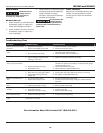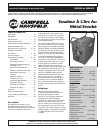
7
www.chpower.com
WS4369 and WS4469
Operating Instructions and Parts Manual
STRIKING AN ARC
Place the bare end of the electrode in
the holder. Grip the holder lightly to
reduce tiring of the hand and arm.
NOTE: Always keep the jaws of the
holder clean to insure good electrical
contact with the electrode.
Be careful not to
touch the work piece
or welding bench with the electrode as
this causes arc flashes.
There are two methods which can
be used to start or strike the arc; the
tapping method and the scratching
method. In the tapping method, the
electrode is brought straight down and
tapped on the work piece. With the
scratching method, drag the electrode
at an angle along the surface much
like striking a match. Regardless of
method, upon contact with the plate,
immediately raise the electrode a
distance equal to the diameter of the
electrode or it will stick to the surface.
Always hold the electrode pointed into
the weld (See Figure 6).
NOTE: Should the electrode stick to the
work piece, break it loose by quickly
twisting or bending at the holder
while pulling upward. If the electrode
does not break loose, disengage the
electrode by releasing it from the
holder.
ARC WELDING BASICS
Five basic techniques affect weld quality.
These are: electrode selection, current
setting, weld angle, arc length, and
travel speed. Proper implementation of
these techniques is necessary for good
weld quality.
ELECTRODE TYPE AND SIZE
The correct choice of electrode type
involves a variety of factors, such as
welding position, work piece material
type, thickness, and condition of
surface to be welded. The American
Welding Society, AWS, has set up certain
requirements for each type of electrode.
All electrodes are classified into five
main groups: mild steel, high-carbon
steel, special alloy steel, cast iron, and
nonferrous such as aluminum. The
majority of arc welding is done with the
electrodes in the mild steel group. The
electrode material should corres- pond
with the work piece material.
Flux coatings are made for use with
either AC (alternating current), DC
(direct current) reverse polarity, or
DC straight polarity, although some
function well on both AC and DC
current.
Welding Guidelines
GENERAL
This line of welding machines utilizes
a process known as Shielded Metal-Arc
Welding (SMAW). This process is used
to bond metals by heating them with
an electric arc created between the
electrode and the work piece.
Electrodes used for shielded metal arc
welding have two parts. The inner
core is a metal rod or wire that should
be similar in composition to the base
metal. The outer coating is called
flux. Various types of flux exist. Each
coating is used for a particular welding
situation.
While the metal is molten, it can be
contaminated by elements in the air.
This contamination could weaken
the weld. The flux coating creates
a protective barrier called slag that
protects the molten metal from
contaminants.
When current (amperage) flows
through the circuit to the electrode, an
arc is formed between the end of the
electrode and the work piece. The arc
melts the electrode and the work piece.
The melted metal of the electrode flows
into the molten crater and forms a
bond with the work piece as shown in
Figure 5.
NOTE: Discontinue using and discard
electrodes that burn down to 1 to 2
inches from the electrode holder.
Figure 5
Weld
Slag
Crater
Work Piece
Flux
Wire
Figure 6
Same as
electrode
diameter
Same as
electrode
diameter
AWS ELECTRODE CLASSIFICATION
E - 6 0 1 3
E = Electrode
60 = Mild steel
70 = High strength
Steel
1 = Electrode can
be used in all
positions
2 = Electrode is
restricted for
use in flat or
horizontal
position only
Flux type


















